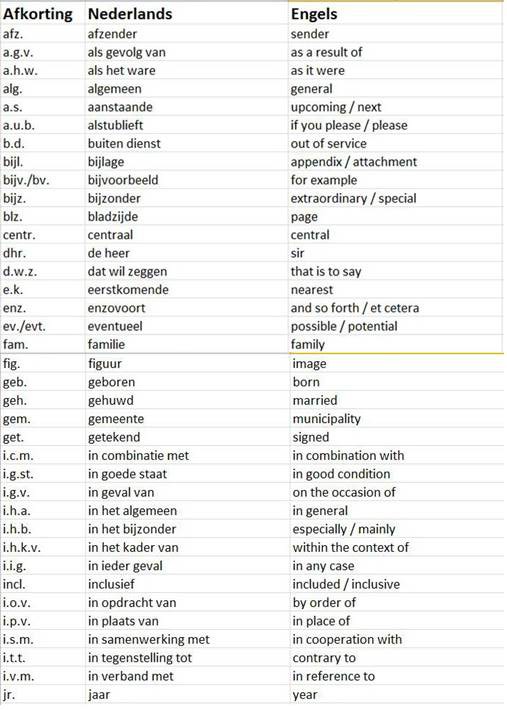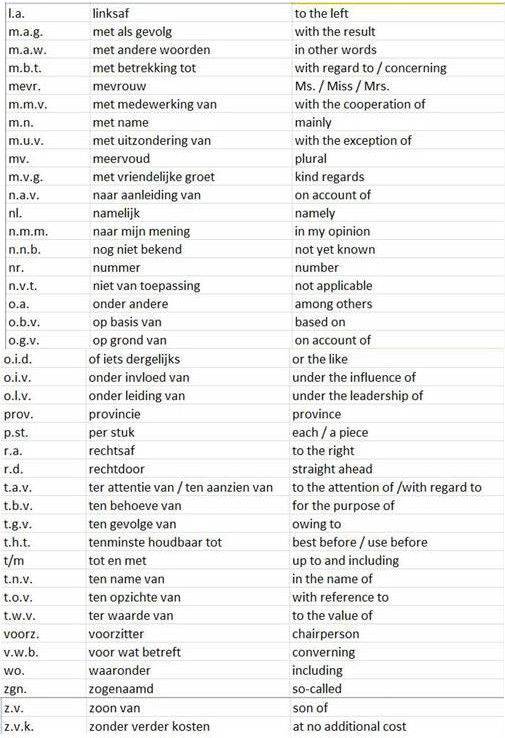
SigNote Cloud / Flickr Creative Commons
In last week’s post, we went over afkortingen (abbreviations) for chattaal (chat language) – think BRB, LOL, etc… but in Dutch.
In a comment on the post, Peter reminded us that there are many, many afkortingen employed in every-day Dutch language that can sometimes make you feel like you’re trying to crack a secret code.
And there are so many of them that’s it’s difficult to keep track.
This can be especially frustrating when they appear in important paperwork or official communications.
They’re the a.s.a.p.’s, the r.s.v.p.’s, the p.s.’s, and the etc.’s of the dutch language.
Here, we’ve done the cracking for you on some of the afkortingen you’re most likely to come across.
Seen any recently that we missed? Let us know in the comments below.










Comments:
Peter Simon:
Hi, Tiffany, that’s great! A few more, as you’ve asked for: e.g. (!) eerstgenoemde (former, mentioned first); p.a., or p/a – per adres (c/o, care of); art. – artikel (item, clause, section); e.o. – en omgeving (and around/and the neighbourhood); e.k. – eerst komende (the one who arrived first), or eerste kwartier (Q1, first quarter); in spite of these, which often look like English abbreviations, the Dutch language does use real English abbreviations and acronyms (b2b, b2c, etc. mainly perhaps in business). Thanks for the new list!
Iris den Boer:
Hi, Tiffany. Great list! I can only think of two others to add: e.e.a. – een en ander (this and that) and sometimes the Dutch use the French s.v.p. (S’il vous plait) instead of a.u.b.
tiffany:
@Iris den Boer Thanks! Love the two additions 🙂 I may have to do a new post with all the extras commenters are adding to the list
Scott Smith:
Nice list, thanks.
I think I’ve seen z.s.m. = zo snel mogelijk a few times.
tiffany:
@Scott Smith Thank you 🙂 Yup! zsm is another very common one. Thanks for adding it on!
Scott Smith:
Oops, = zo spoedig mogelijk actually
http://nl.wiktionary.org/wiki/z.s.m.
tiffany:
@Scott Smith 🙂 I’ve actually seen it both ways
K.v. Ankeren:
How about b.g.g. – bij geen gehoor. – no answer to the bell!
Jaina:
I’ve seen very often “i.i.g” or “iig” = in ieder geval.
Awesome post!!!
Jaina:
Oops, I just saw it’s in the list, my bad ! 🙂
Chantel:
There is also jl which is I believe ‘jongstleden’ and means last as in last week or last month. Confused me for a while. Thanks for compiling this. I see afkortingen in emails all the time so this is a big help.
Mare:
Wvttk – Wat verder ter tafel kom. last item on the agenda in business meetings 🙂
Mare:
kom = komt
Karen:
And quite commonly used @facebook : idd – inderdaad -> mening absolutely or indeed
Sten:
@Karen Yep! Thanks, forgot about that one 🙂 very often used
Slavic:
I find this one very often on markplaats:
Zgan – zo goed als nieuw (as good as new, in mint condition)
Sten:
@Slavic Yes, indeed!!!
Jen:
Tiffany, I have a bit of text that I found during a geneology search, and it contains two abbreviations I can’t figure out: “tr.” and “dr.” Can you help me figure out what it means? The text reads: Nijmegen op 30 1855 tr. (resp. ongeveer 29 en ongeveer 32 jaar oud) Nijmegen op 3 feb 1813 met Elisabeth van (Hengsbergen) Hingsbergen, dr. van Willem van Hensbergen en Maria Margaretha Naehrlings (Neerling, ged. Hervormd Nijmegen op 10 jan 1781, Dienstmeisje, ovl. (ongeveer 85 jaar oud) Nijmegen op 6 apr 1866.
I typed in the entire thing in case that may be important in interpreting the text. Thank you so much!
Sten:
@Jen Hi Jen!
I am Sten, and together with Jakob and Karoly, we have run the blog for a while. Tiffany is not on the team anymore, unfortunately.
Anyway, to your question!
Yeah, the Dutch like their abbreviations… I found a website that offers a small list of abbreviations used specifically for genealogy: http://www.pleijsier.publius.biz/genealogy/Pages/tekens.php
From this, it follows that “tr.” means “getrouwd” (married), or in this context “trouwdag” (day of marriage). So the marriage date would be 3 February 1813, I suppose.
“dr.” is a normally a common abbreviation, which is used for (older) men as a formality: “dr.” stands for “de Heer” (Mister).
However, in this context, that makes no sense. Again, the link above helps us out! “dr.” is used as an abbreviation for “dochter” (daughter), and that makes sense! It follows that Elisabeth van Hensbergen is the daughter of Willem van Hensbergen and Maria Margaretha Naerhlings.
I hope that helped!
Sten
Tiffany:
Hi Jen,
I’m actually no longer a blogger here, but for some reason I still get comment notifications sent to my email. I see Sten beat me to it though 🙂
Yes, in this case, dr. stands for dochter (daughter) and tr. for trouwdag.
A slight correction on Sten’s comment, however. Dr. is a common abbreviation, but it stands for dokter (doctor), the same as in English. The abbreviation for de heer (Mr.) is dhr.